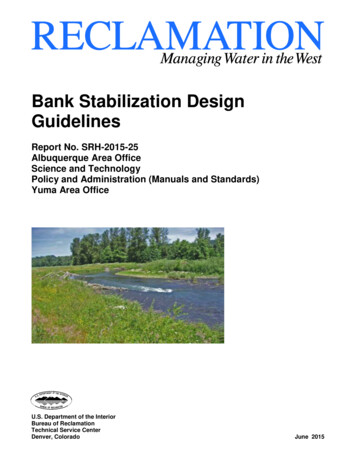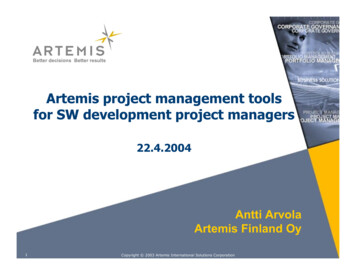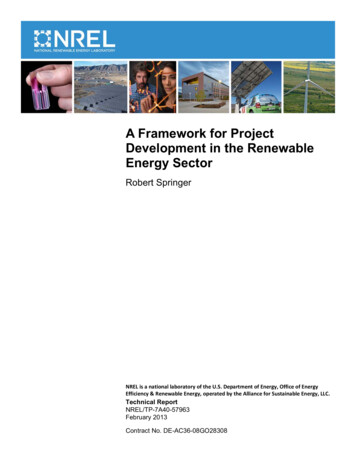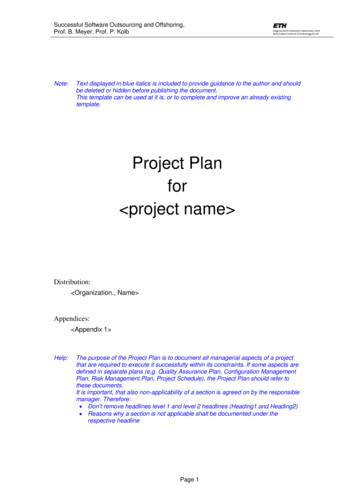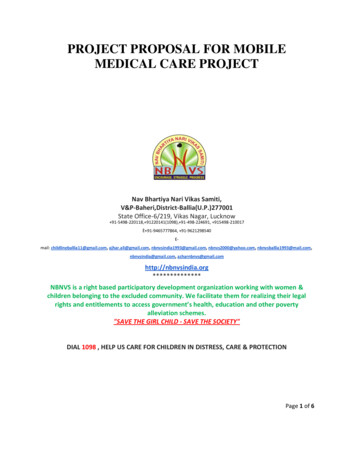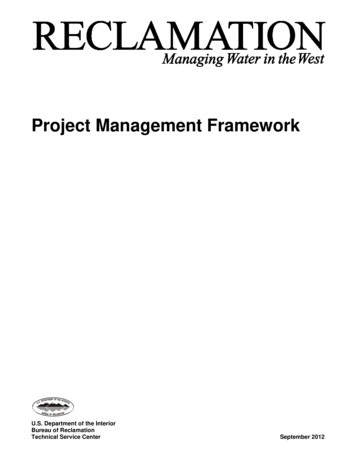
Transcription
Project Management FrameworkU.S. Department of the InteriorBureau of ReclamationTechnical Service CenterSeptember 2012
Mission StatementsThe U.S. Department of the Interior protects America’s natural resourcesand heritage, honors our cultures and tribal communities, and supplies theenergy to power our future.The mission of the Bureau of Reclamation is to manage, develop, andprotect water and related resources in an environmentally and economicallysound manner in the interest of the American public.
Project Management FrameworkU.S. Department of the InteriorBureau of ReclamationTechnical Service CenterSeptember 2012
Abbreviations and P/PMFAIFYITNEPAO&MOMBOMB 300PM FrameworkPMBOK C.WBSActual CostAmerican National Standards InstituteBudget at CompletionComprehensive Program SeriesCoordination and Oversight GroupCost Performance IndexCost VarianceDeputy Commissioner, OperationsU.S. Department of the InteriorEstimate at CompletionElectronic Service Agreement ModuleEarned ValueEarned Value ManagementFederal Acquisition Certification forProgram and Project ManagersFederal Acquisition InstituteFiscal YearInformation TechnologyNational Environmental Policy ActOperation and MaintenanceOffice of Management and BudgetOffice of Management and BudgetCircular A-11, Part 7, Section 300Project Management FrameworkA Guide to the Project ManagementBody of Knowledge, fourth edition, 2008Project Management InstituteProject Management ImplementationTeamProject Management OfficeProject Management PlanProject Management TeamProject Review BoardPlanned ValueReplacements, Additions, andExtraordinary MaintenanceBureau of ReclamationStanding Operating ProceduresSchedule Performance IndexSchedule VarianceTechnical Service CenterUnited States CodeWork Breakdown Structureiii
Executive SummaryProject performance and success can be significantly improved by applyingproject management knowledge, processes, skills, tools, and techniques. This isincreasingly accepted across all industries. This integrated Project ManagementFramework (PM Framework) is intended to add value to the organization byoutlining a body of knowledge, processes, skills, tools, and techniques that, whenused, will improve the Bureau of Reclamation’s (Reclamation) performance inconducting its work.The PM Framework integrates existing Governmentwide and U.S. Department ofthe Interior (DOI) project management requirements and clarifies projectmanagement practices for those projects for which no specific mandates alreadyapply. The PM Framework also establishes metrics that will enable Reclamationto measure how well it is administratively instituting project management andhow well this practice is improving the agency’s actual performance inaccomplishing its workload.While Reclamation is efficient in accomplishing projects, it can improve the wayit manages its workload. Some portions of the organization are very successful inmanaging projects to reach completion on time and within budget and can provide“best practices” for other portions to overcome challenges.To maximize the success of projects throughout the organization, Reclamation iscommitted to implementing effective project management at all levels and forall types of project work, including construction projects, Information Technology(IT) projects, and other projects. In certain cases, project management processesare already mandated by DOI or higher level governmental policy. Thisdocument does not supersede any of the mandated processes; rather, it providesguidance for, and specifically focuses on, providing scalable requirements forsituations in which Reclamation retains discretion on the level and type of projectmanagement requirements.The principles laid out in this PM Framework can be used for almost any kind ofactivity, including environmental efforts, water contracting or marketing actions,planning studies, or even short-term assignments dealing with specific resourcemanagement issues.In 2007, the Office of Management and Budget (OMB) issued directives forExecutive Branch agencies to establish a structured development program forprogram and project managers. Since then, DOI and OMB have refined anddeveloped additional requirements that must be integrated into Reclamation’sbusiness practices. In 2009, Reclamation first issued policies and directives andstandards for project management. In June 2011, Reclamation’s DeputyCommissioner, Operations, directed the Coordination and Oversight Group(COG) to establish the Project Management Implementation Team as a subteamv
Project Management Implementation Frameworkof the COG and tasked the team with developing an integrated ProjectManagement Framework with the objective to guide the consistent administrationand practice of project management for all programs, projects, investments, andinitiatives. This document is the culmination of that work.Key guiding principles of this PM Framework include:The PM Framework must add value to the performance of the agency inconducting its work by clarifying project management practices for thoseprojects where no specific mandates apply.The application of project management to individual activities must bescalable to the size, sensitivity, scope, and complexity of the project, whilealso using common means to execute, track, and report project status.Implementation of the PM Framework must balance the need for afundamental level of consistency across the agency by providingflexibility to each directorate to implement and apply the projectmanagement principles that work best for its organization.TerminologyIn many professions and disciplines, terminology can have specific meanings ordifferent meanings for the same terms. This applies also to project managementand how it affects current language used in Reclamation. Many terms are usedthroughout Reclamation that relate to the discipline of project management. Toensure consistency, minimize confusion, and promote common understandingacross Reclamation, critical terms have been identified in Section II,Terminology, and Section V, Glossary.AdministrationHaving an administrative and governance structure within each directorate iscritical for establishing an organizational framework that incorporates projectmanagement principles into its operations. Each directorate is responsible forestablishing policies, procedures, and organizational structures that promote theapplication of project management. Within this context, this PM Frameworkprovides the flexibility necessary for directorates/offices to implement projectmanagement principles to meet their unique business needs. The PM Frameworkestablishes guidelines for defining and managing projects categorized as Basic,Standard, Complex, and Complex with OMB 300 and recommends the type oftraining and certification requirements aligned with each category. The Complexwith OMB 300 category applies the higher level DOI and OMB requirements tovi
Project Management Implementation Frameworkprojects subject to Circular A-11 and DOI policy, while the other three categoriesprovide a framework for Reclamation directors to exercise the discretion left tothem.Project Management ProcessesTo understand the value of project management, it is necessary to understand thefundamental nature of a project; the core characteristics of project managementprocesses; how success is evaluated; the roles, responsibilities, and activities of aproject manager and the expertise required; and the context in which projects areperformed.The PM Framework references a certification known as Federal AcquisitionCertification for Program and Project Managers (FAC-P/PM). This is a set ofcommon, essential competencies developed by the Federal Acquisition Institute(FAI) for the program and project management community. While the FAI hasestablished the training, experience, and competencies required for certification, itdoes not provide detailed project management process guidance.To define project management processes, the PM Framework integrates theconcepts set forth by the Project Management Institute in its publication, A Guideto the Project Management Body of Knowledge, fourth edition, 2008, along withthe requirements set forth in Governmentwide, DOI, and Reclamation policies.The project management processes are organized into five process groups:initiating, planning, executing, monitoring and controlling, and closing:Initiating defines and authorizes the project and defines how the overallproject will be managed from start to finish.Planning defines and refines objectives and develops the ProjectManagement Plan (PMP), which is the course of action required to attainthe project’s objectives and scope.Executing integrates people and other resources to carry out thePMP activities for the project.Monitoring and controlling regularly measures and monitors progress toidentify variances from the baseline PMP so that corrective action can betaken, when necessary, to meet project objectives.Closing formalizes acceptance of the product, service, or result; brings theproject, or a project phase to an orderly end; and transitions to operationsor to the next project phase.These processes are used throughout the life cycle of a project.vii
Project Management Implementation FrameworkProject Management Process GuidelinesThe five groups of processes include a very broad range of individual processes.It is important for practitioners within Reclamation to understand the individualprocesses that must be adapted and applied to suit each individual project.Smaller, simpler projects may require the use of less formal processes, whereaslarger and more complex projects typically require more structured processes. Inshort, although project management follows standard practices and guidelines, itis scalable and adaptable to each particular project.Project Life CycleThe project life cycle for a Reclamation project may include multiple phases orsubprojects within the context of a single overall project. Project phases in acomplete project life cycle are not the same as project management processgroups. In fact, the process groups may need to be repeated for each phase.The end of each phase is marked by a milestone. There are a multitude of phasesand milestones currently in use throughout Reclamation, depending on theorganization and the type of project. Despite the differences, all projects willfollow the agency project life cycle, which consists of four broadly definedproject phases:1. Starting the Project:Example Activities: Developing the project charter, authorizing memo oremail, obtaining output from another project, formulating serviceagreements, etc.Example Outputs: Project charter developed, including designation ofproject manager, identification of project category (Basic, Standard,Complex, or Complex with OMB 300), and preliminary project costestimate.Example Milestones: Review of project charter, decisions, preliminarycosts. Go/no-go decision made to proceed to next phase of project.2. Organizing and Preparing:Example Activities: Preparing the PMP, appraisal study, feasibility study,planning study, value planning study, etc.Example Outputs: Signed PMP, environmental and other requiredprocesses and permits, appraisal design, feasibility design, final design,and significant acquisitions/procurement events.Example Milestones: Milestone review of outputs, authorization ofrecommendations, and approval to move to next phase.viii
Project Management Implementation Framework3. Carrying Out the Work:Example Activities: Executing work orders, design, acquisition, delivery,construction, etc.Example Outputs: Product or system, results, and documentation thatwork is complete.Example Milestones: Review of deliverables and artifacts, andconstruction or delivery results. Authority to proceed to deployment,operations, or operation and maintenance (O&M).4. Closing the Project:Example Activities: Review and approval of deliverables, developingdelivery memo and other final reports, commissioning, transfer offacilities, as-built drawings, Standing Operating Procedures,O&M manuals, contract closeout, and COG closeout report.Example Outputs: Closeout report completed, lessons learned, and teamclosure.Example Milestones: Post Implementation Review, Termination/ChangeReview, Decommissioning, or Succession Review.The wide range of phase activities, outputs, and milestones that are developed forany particular type of project throughout Reclamation falls within theseoverarching high-level phases. A given activity may fall into a different phase,depending on the type of project. For example, for a design and constructionproject, the environmental approvals and permits may be part of the “Organizingand Preparing” phase, where for a strictly environmental project, they would fallinto “Carrying out the Work.” The five groups of project management processes(as previously defined) are applied during each phase to efficiently guide theaccomplishment of any particular project.MetricsThe PM Framework establishes standardized metrics to measure progress towardestablishing a project management program Reclamationwide, beginning in fiscalyear (FY) 2013. Two types of metrics will be collected: one set will measureReclamation’s progress toward implementing a project management program; theother set will measure the effectiveness of that program. The COG will collectdata on the performance metrics, which will be included in the COG FY reports.ix
ContentsPageAbbreviations and Acronyms .Executive Summary .I.Introduction.A. Goals and Objectives for Implementing ProjectManagement Throughout Reclamation.
SOP Standing Operating Procedures SPI Schedule Performance Index SV Schedule Variance TSC Technical Service Center . U.S.C. United States Code WBS Work Breakdown Structure . iii . Framework ( Executive Summary Project performance and success can be significantly improved by applying project management knowledge, processes, skills, tools, and techniques. This is increasingly accepted
